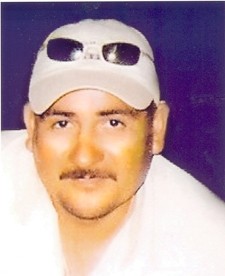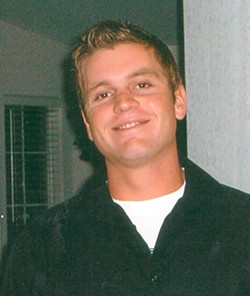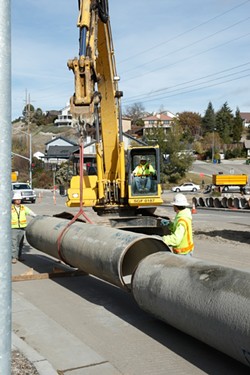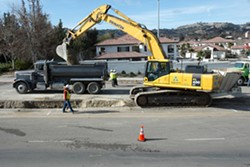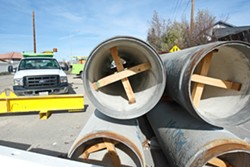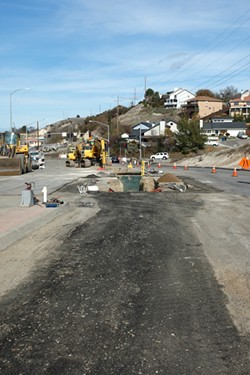[{
"name": "Newsletter Promo",
"id": "NewsletterPromo",
"class": "inlineCenter",
"insertPoint": "4",
"component": "15264767",
"requiredCountToDisplay": "0"
},{
"name": "Ad - Medium Rectangle CC01 - 300x250",
"id": "AdMediumRectangleCC01300x250",
"class": "inlineCenter",
"insertPoint": "8",
"component": "2963441",
"requiredCountToDisplay": "12"
},{
"name": "Ad - Medium Rectangle LC01 - 300x250",
"id": "AdMediumRectangleCC01300x250",
"class": "inlineCenter",
"insertPoint": "18",
"component": "2963441",
"requiredCountToDisplay": "22"
},{
"name": "Ad - Medium Rectangle LC09 - 300x250",
"id": "AdMediumRectangleLC09300x250",
"class": "inlineCenter",
"insertPoint": "28",
"component": "3252660",
"requiredCountToDisplay": "32"
}]
The sun had just set on a mild October night when Bob Gaines’ phone rang. He was at dinner with friends and on the other end of the line his ex-wife, Cindy Conte, was hysterical. There had been an accident, she told him, and their son Jake was in trouble. Neither knew then that Jake and a coworker, Manuel Villagomez, were trapped in a pipe, engulfed by torrents of water.
Jake and Manuel drowned. Jake, who was 24 years old, and Manuel, 38, were laborers for Teichert Construction, one of five companies contracted to lay 45 miles of water pipe from Lake Nacimiento to San Luis Obispo.
Bob and Cindy were in Bakersfield at the time; Jake and Manuel were 120 miles distant in Paso Robles, normally a two-hour trip. They drove to the accident scene in just over
an hour.
As Bob rushed toward the site, he shot calls back and forth with Jake’s stepfather, Tony Conte, a foreman who was also working the pipeline at a nearby site. Bob said he knew the accident was bad, but just as he reached Paso Robles, the coroner took the phone to give directions and Bob realized how bad it really was.
He finally reached the intersection of Niblick and North River roads, where construction workers were standing, dazed. Emergency crews had just pulled the two lifeless bodies from the murky, sopping trench and were sealing them in bags. Jake and Manuel’s remains were cold; their skins wrinkled and coated with sand.
Bob remembered his son as a popular, energetic wakeboarder and football player who had some trouble in his teenage years but “made sure he met his obligations and busted his butt at work.” Jake was thrilled when he got the job in Paso Robles, Bob said, but was there only for about two weeks before his death.
Manuel was a Mexican native with four brothers and sisters and two parents who still live in Mexico, according to his obituary. Manuel left behind a wife, a son, and a daughter. Jake left behind a 2-year-old daughter.
Bob is a 28-year veteran of the Kern County Sheriff’s Department. For the most part, Bob talked about the incident with the tone of someone who’s used to reading autopsy reports. His speech was steady, almost clinical.
That changed when he talked about Jake. His body tensed. He rubbed his hands. He shifted in his seat, often twitching. He said it took about two days for the reality to sink in. He had unrelenting nightmares.
About ten weeks after the accident, Bob was mailed a copy of the SLO County coroner’s report, which includes everything from witness statements to the autopsy report. Reading the report felt like a punch in the stomach, he said: “I know a lot of things went bad that night, but I didn’t realize there was that much negligence going on.”
Jake and Manuel lived their last moments trapped in a 30-inch-diameter pipe with little hope of escape. Rushing water had flung them deep into the pipe like a blast.
The pipe was at the bottom of a small trench: 10 feet deep and nine feet wide. Jake and Manuel were there to remove wooden support struts as each new pipe section was set.
Jake was about 100 feet down the length of the pipe with Manuel behind him. Jake’s job was to bang out the struts and load them on a dolly; Manuel would cart and hand them to one last worker, Jason Limon, at the open end of the pipe.
Even as the three men were in the trench, an excavator was digging to the north, inching closer to an existing 8-inch water line neither the operator nor anyone in the trench knew about.
The excavator tore through the line. The only warning was a loud pop before thousands of gallons of water gushed into the trench.
The flood toppled Limon and pushed him just inside the pipe. Manuel turned his head to see what happened before being flushed farther into the pipe, Limon later told an investigator. Limon managed to scramble out of the trench but Manuel and Jake were swept away. By the time Limon made it to the street, the water had already filled the pipe.
Zach Duggins was operating the excavator. He tried to use the scoop to plug the surging water but the force was too great, according to his statement in the coroner’s report. Next, he tried to block the pipe opening but the trench had already filled.
Crews removed steel plates that covered the opposite end of the pipe in hopes Manuel and Jake could escape there. Meanwhile, someone ran to turn off the water (witness accounts in the coroner’s report differ over who). Even with the valve shut, water continued to pour into the trench and overflow onto the street. Reportedly, the line was pressurized from multiple directions and another valve had to be shut to stop the flow. After the plates were pulled, all anyone could do was wait, said Garred Oldham, whose job was to assist the excavator operator. Oldham said he left to direct traffic down the road—he didn’t want to be nearby when the bodies were retrieved.
It took emergency crews more than an hour to drain the water and remove the bodies of Jake and Manuel, which were found limply tangled together, surrounded by tools and wood planks, 114 feet down the pipe.
The incident seemed to leave everyone stunned and asking the same question: Why didn’t anyone know about the active 8-inch water line?
Paul Satti is the technical director of the Construction Safety Council, a nonprofit national safety organization located just outside of Chicago. He said it’s standard practice to identify all underground hazards before digging.
In fact, procedures were no different in this case. On several occasions, the pipe was identified, according to witness statements in the coroner’s report. Even on the night of the accident, the digging was temporarily stopped because of the pipe.
According to several statements in the coroner’s report, the site foreman, Henry “Hank” Duggins—the father of the excavator operator, Zach Duggins—told crews to keep digging. He told an investigator, the coroner’s report describes, that there was confusion about whether there actually was a pipe. He blamed that confusion, in part, on the wrong pair of eyeglasses and an upside-down map. It was only about five minutes after the digging resumed that the excavator shredded the pipe, Oldham estimated. Neither Hank Duggins nor his attorneys could be reached for further comment.
Crews are once again hustling to lay the remaining pipe just north of the accident site. The trench has been filled and covered with asphalt. A few bouquets of flowers, some of them dry and wilted, and signs handwritten in black marker are some of the only reminders of what happened.
“God bless you both,” reads one sign.
What pipe?
No one at the job site knew about the active water line. It fell to two men from other construction sites to tell Zach Duggins, the excavator operator, to stop digging.
Steven Arington is an inspector for Jacobs Engineering, the construction-management company for the Nacimiento project. According to several witness statements, Arington and Conte, Jake’s stepfather, told crews to stop digging. That was before they went to talk with Hank Duggins.
Using what were described in the coroner’s report as “Google” maps, the three men tried to determine whether there actually was a water line. There were no blue markings on the roadway and there had been no “pot holing” tests to identify underground utilities, according to the coroner’s report. Various statements in the report seem to conflict and people at the site pointed fingers at each other, saying that someone else was responsible for finding the water line.
Crews had marked the road with a yellow line over an existing gas pipe.
Oldham estimated that the excavator was shut down for about a minute while Arington and Conte went to tell Hank Duggins about the water line. Zach Duggins told investigators he had stopped digging for longer, about five minutes. But both said Hank had told them to resume digging. Oldham and Zach did as they were instructed.
Oldham said he was told by Hank, “Don’t worry about it.”
When the pipe burst, it knocked over a ladder leading out of the trench. Oldham said he ran to pick up the ladder, but by that time the water had already filled the pipe.
Arington, Conte, and Hank went to review the maps immediately before the rupture. They could not see the excavator, according to the coroner’s report. Arington told the investigator he heard a “distinctive pop.” When the water main was breached, the men were still arguing about whether it was even there.
Arlington said he had been told not to comment further, when contacted by New Times.
Conte did not respond to calls for comment.
That night wasn’t the first time Teichert crews were told about the water line. Aaron Borden, with the Paso Robles Public Works Department, told investigators he had shown Hank where the pipes were located, both on maps and at the site itself about two weeks earlier.
Borden declined to comment further and referred to Water Resources Manager Christopher Alakel, who would not address specifics of the accident. He said that water department officials were sent to job sites “every once in a while” because “we knew that they were going to be impacting some of our utilities.”
According to Borden’s statements in the coroner’s report, he arrived at the site, made sure the water was off, and began pumping water out of the trench.
“While he was working the pumps, Hank came up to him and said, ‘How come you didn’t tell me that the water line was there?’” Borden relayed to an investigator. “He told him he did. Hank said, ‘Oh, maybe the map was upside down.’”
Hank also told an investigator that he was using Conte’s glasses to read the maps. All three men saw a line, but couldn’t agree on what it meant.
Satti, of the safety council, explained that trenches and other excavations are among the most dangerous types of jobs for construction workers. Trench and excavation accidents are among the top four Occupational Safety and Health Administration concerns, along with falls, electrocutions, and being struck by an object.
According to the U.S. Department of Labor, there were 1,152 construction-related fatalities in 2007. Construction laborers accounted for 340 of those fatalities.
There are no specific rules that ban workers from being in a trench while there is digging, Cal OSHA spokesperson Erika Monterroza said. Most OSHA regulations deal with trench cave-ins and preventing workers from being pummeled by rocks or other objects that might tumble down the digging site.
Monterroza said trench deaths are uncommon in the construction industry—there were three fatalities last year. However, workers in trench accidents are more likely to be killed than in other types of accidents.
OSHA has pages of rules and safety guidelines related to trench digs, mostly to protect workers from collapses. Not only is it acceptable for people to be in a trench while it’s being excavated down the line, but it’s often a necessary part of the job, Monterroza said.
Still, Satti noted that there are many types of safety mechanisms to protect workers in a trench. So when there is a death, he said, “It’s inexcusable.”
Now what?
What happens next hinges on the OSHA report.
OSHA investigators will determine whether mistakes were made and if so, who made them. Depending on those findings, the penalties could be as minor as a fine or as severe as a criminal sentence. The report is under final review at the agency and could be complete within days, or weeks. While the OSHA finding is in progress, almost no one is talking.
Neither Hank nor Zach Duggins returned calls from New Times. Their attorney, Robert Peterson, who specializes in OSHA cases, did not return calls. Neither did Teichert’s representative Nancy Moorhouse, the company’s director of safety.
Teichert Vice President Steve Mitchell said he had not yet seen the coroner’s report, but was told that no criminal charges would come from the coroner’s office. Sheriff’s Department spokesperson Rob Bryn said the department does not bring criminal charges for industrial accidents; that responsibility rests with OSHA officials and the district attorney.
Mitchell added that Hank is still employed by Teichert, although he is working on a different project. He said Teichert has a stellar safety record and there has not been a Teichert employee fatality since the late ’80s. “Obviously this was disturbing to have this happen to us and to our employees,” he said. The Sacramento-based company has been in business for about 120 years, he added.
Mitchell said there had been no action against Teichert following the accident, and company representatives were working with the families of Jake and Manuel.
“We’ve had contact with the families … to ensure that they’re taken care of at this time, but nothing in terms of any litigious activities at this point.”
Manuel’s family has hired David Mustagni Sr. of the firm Mustagni, Holstedt & Amick. Mustagni Sr. could not be reached for comment before press time and the firm’s investigator, Ken Stites, declined to answer any questions. Manuel’s family also could not be reached.
Limon, the man who narrowly escaped death in the trench, said he would not answer any questions before talking to his attorney and could not be reached again despite numerous follow-up calls.
So far, Limon is the only person who has made a court filing; a negligence claim against SLO County on Dec. 17, citing “extreme emotional distress” and asking for $500,000. County officials have rejected the claim and said it should be directed against Teichert.
The mother of Jake’s daughter was agitated when contacted by New Times and asked not to be named. Although she has hired an attorney, she declined to give the name and quickly hung up.
Bob Gaines clearly was uncomfortable talking about his son. He seemed more at ease discussing the accident, treating it like little more than the coldly impersonal words of the coroner’s report. Yet, although he was agitated and angry about Jake’s terrible death, he did beam with a father’s pride. He said Jake didn’t particularly like working in the claustrophobic pipes, but overcame his fears and did it anyway “because that’s the type of guy he is.” ∆
Staff writer Colin Rigley can be reached at [email protected].
Latest in News
Readers also liked…
-

Coast Unified teachers upset over new position's salary and qualifications
Oct 20, 2022 -

SLO police identify alleged driver who hit and killed couple
Dec 22, 2022 -

When the levee breaks: Oceano residents, county officials walk a tightrope of regulations to manage Arroyo Grande Creek, which some say led to the levee's failure in January
May 18, 2023

